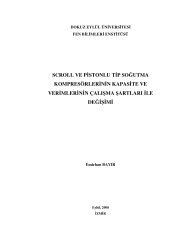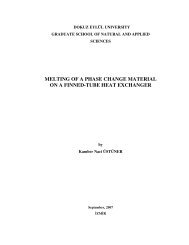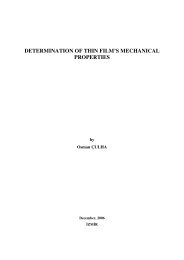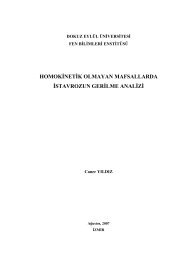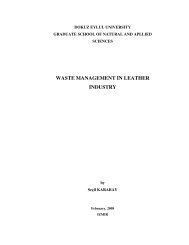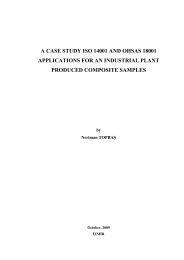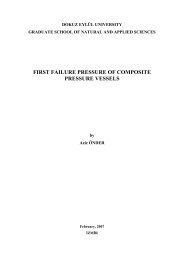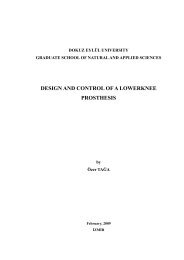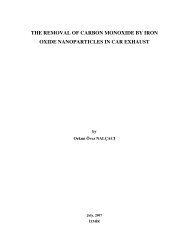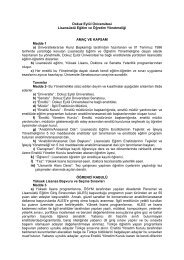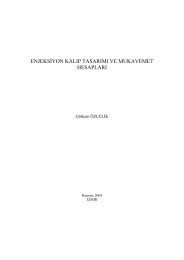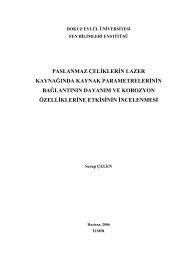A numerical study on the thermal expansion coefficients of fiber
A numerical study on the thermal expansion coefficients of fiber
A numerical study on the thermal expansion coefficients of fiber
You also want an ePaper? Increase the reach of your titles
YUMPU automatically turns print PDFs into web optimized ePapers that Google loves.
41<br />
where<br />
θ<br />
1<br />
K<br />
( K<br />
c<br />
− K<br />
f<br />
)<br />
( K − K )<br />
K<br />
( K<br />
m<br />
− K<br />
c<br />
)<br />
( K − K )<br />
m<br />
f<br />
= , θ<br />
2<br />
=<br />
(3.13)<br />
K<br />
c m f<br />
K<br />
c m f<br />
In <strong>the</strong>se equati<strong>on</strong>s K c , K f and K m represent <strong>the</strong> bulk moduli <strong>of</strong> <strong>the</strong> composite, filler<br />
and matrix respectively. The simplicity <strong>of</strong> this approach is attractive, but it c<strong>on</strong>verts<br />
<strong>the</strong> problem <strong>of</strong> calculating α c to knowledge <strong>of</strong> K c or an ability to calculate it from <strong>the</strong><br />
properties and volume fracti<strong>on</strong>s <strong>of</strong> <strong>the</strong> individual comp<strong>on</strong>ents.<br />
3.4.1.5 Equati<strong>on</strong> <strong>of</strong> Schapery<br />
Schapery (1968) has derived expressi<strong>on</strong>s for <strong>the</strong> l<strong>on</strong>gitudinal and transverse<br />
effective <strong>the</strong>rmal expansi<strong>on</strong> <strong>coefficients</strong> both for isotropic and anisotropic<br />
composites c<strong>on</strong>sisting <strong>of</strong> isotropic phases, by employing extremum principles <strong>of</strong><br />
<strong>the</strong>rmoelasticity.<br />
He c<strong>on</strong>sidered a specimen under a space wise uniform temperature in <strong>the</strong> form <strong>of</strong><br />
a rectangular parallelepiped whose edges are parallel to coordinate axes and with unit<br />
volume. This specimen is statistically homogeneous and composed <strong>of</strong> n phases<br />
(c<strong>on</strong>stituents), each <strong>of</strong> which has homogeneous mechanical and <strong>the</strong>rmal properties<br />
that are different from any o<strong>the</strong>r phase. No restricti<strong>on</strong> is placed <strong>on</strong> <strong>the</strong> temperature<br />
dependence <strong>of</strong> c<strong>on</strong>stituent properties. Maximum dimensi<strong>on</strong>s defining <strong>the</strong> specimen’s<br />
structural inhomogeneity are assumed small compared to specimen dimensi<strong>on</strong>s and<br />
<strong>the</strong> interacti<strong>on</strong> between phases is c<strong>on</strong>sidered to be purely mechanical and linear. Also<br />
specimen and phases are assumed unstressed and unstrained when surface tracti<strong>on</strong>s<br />
are zero and <strong>the</strong> temperature is at some reference value.<br />
As a result, for a unidirecti<strong>on</strong>al two phase composite, <strong>the</strong> <strong>the</strong>rmal expansi<strong>on</strong><br />
coefficient in <strong>the</strong> l<strong>on</strong>gitudinal directi<strong>on</strong> is<br />
α<br />
E<br />
α<br />
υ<br />
+ E<br />
α<br />
υ<br />
f f f m m m<br />
1<br />
= (3.14)<br />
E<br />
f<br />
υf<br />
+ E<br />
mυm



